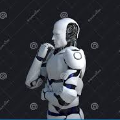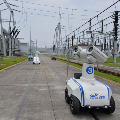Technological evolution in the field of robotics is emerging with major breakthroughs in recent years. This was especially fostered by revolutionary new software applications leading to humanoid robots. Humanoids are being envisioned for manufacturing applications to form human-robot teams. But their implication in manufacturing practices especially for industrial safety standards and lean manufacturing practices have been minimally addressed. Humanoids will also be competing with conventional robotic arms and effective methods to assess their return on investment are needed. To study the next generation of industrial automation, we used the case context of the Tesla humanoid robot. The company has recently unveiled its project on an intelligent humanoid robot named Optimus to achieve an increased level of manufacturing automation. This article proposes a framework to integrate humanoids for manufacturing automation and also presents the significance of safety standards of human-robot collaboration. A case of lean assembly cell for the manufacturing of an open-source medical ventilator was used for human-humanoid automation. Simulation results indicate that humanoids can increase the level of manufacturing automation. Managerial and research implications are presented.
翻译:过去几年中,机器人技术在软件应用方面取得了重大突破,尤其是人形机器人技术的应用。人形机器人在制造上具有良好的应用前景,可以与人类团队协同作业。但其工业安全标准和精益制造实践的应用查询尚不充分。人形机器人与传统机械臂将会有竞争关系,需要有效的回报评估方法。本文以特斯拉(Tesla)人型机器人项目为背景,研究工业自动化的下一代,提出了将人形机器人应用于制造自动化的框架,并且介绍了人-机协作的安全标准的重要性。为了研究人-人形机器人自动化,本文提出了一个用于制造开源医疗呼吸机的精益装配单元的案例。结果表明,人形机器人可以提高制造自动化的水平。同时提出了管理和研究意义。





